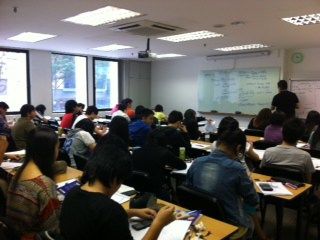2012 GCE O’ Level Principles of Accounts (POA) Suggested Solutions!
After hearing that Miss Loi’s Joss Sticks website crashed even before E MathsPaper 2 solutions were out,
I wondered if we had to do backups to avoid the same fate… except that I’m reminded that POA is taken by only approximately 20% of the cohort. 😉
So I have 1/5 the same risk. 😉
The weekend was abuzz with activity at YMCA, where we had the largest party turnout for the annual crash course over two days.

Predicted topics include doubtful debts, liquidity, profitability, partnership, control accounts, bank recon, amalgamation, control accounts, correction of errors and incomplete records.
75% of the Sample Paper 1 & 2 collectively came out in this year’s paper. Much to our delight. 🙂
And without further ado…. we present,
RE-UPed Version 2 with contributions from commentators.
7092/01 GCE O’ Level Principles of Accounts 2012 Paper 1 Suggested Solutions
7092/02 GCE O’ Level Principles of Accounts 2012 Paper 2 Suggested Solutions
Right Click on Each Link And “SAVE AS.” File size may be quite big, so be patient.
Caleb’s Comments
THEORY
Paper 1 – 17 marks
Paper 2 – 16marks.
Total 33 marks.
This is fairly consistent with 2011 paper (32-34 marks, depends on which question you chose for Section B for Paper 2).
Student’s ability to make comparison on performance and liquidity of business (consisting 15 marks of 33) should excel in this year’s papers.
ACCOUNTS & APPLICATION
Paper 1
Students complain the paper was too easy.
Working capital was a generous 5 marks. Complacency might have killed those who failed to show workings. The instruction was extremely clear. I hope you caught that and did accordingly.
Paper 2

This year’s Paper 2 had some notably challenging questions. I am happy that challenging questions which require understanding and application came out so that deserving students can get a decent shot of doing well.
P2 Q1 NP figure is $28,250. Balance Sheet $83,320.
Student’s ability to account for Decrease in Doubtful Debts, Bank Charges (Dr Bank Charges and Cr Bank) and setting Surjit’s $150 dr balance as negative in the balance sheet were perceived to be differentiators of those who do well and those who will excel.
P2 Q4 Tests the student’s ability to calculate depreciation using NBV figures of fixed assets.
P2 Q5 Bad Debts Recovery T-account was asked for the first time. Dates and remembering to transfer it to Profit and Loss are the two major landmines to watch out.
P2 Q5 Capital Account – Students must know to put the right details in the Capital account for additional capital contributed and Drawings made.
Discussing Answers Online.
Constructive comparison to achieve understanding is fine.
However, I’m no genie. This remains as Suggested Solutions.
I’ll be happy to stand corrected and update the document from your contributions. 🙂
Please don’t ask me if this or that mistake will cost me 1 or 2 marks. Your guess is as good as mine.
Errors can be carried forward and will not be marked down twice, provided you showed workings for the remaining figures. It amazes me constantly that students take workings, dates and details for granted.
Concluding Thoughts
Of course I’ll say I wish you guys, especially my students, the very best grades and may getting your As and Bs help you advance in your academic journey towards the next step. Suffice to say, I’ll end by sharing with you a note by Tong Yee, director of The Thought Collective, for his batch of General Paper students.
“My Last Lesson to You: For the Batch of 2012” (FaceBook note)
It deeply resonates with my heartbeat as an accounting educator. My wish is that the accounting knowledge you learn in POA help you understand and appreciate in future the volatile financial landscape we are in and develop skills to cope with challenges and overcome them with good, critical thinking.
With that, all the best for your remaining papers!
Cheers,





